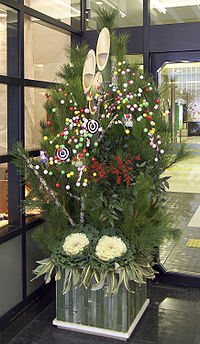Japanese New Year
| Japanese New Year | |
|---|---|

The kadomatsu is a traditional decoration for the new year holiday.
|
|
| Official name | Shōgatsu (正月) or Oshogatsu |
| Also called | new year |
| Observed by | Japanese |
| Type | Cultural |
| Significance | Celebrates the new year |
| Observances | Holiday |
| Begins | December 31 |
| Ends | January 4 |
| Date | January 1 |
| Next time | 1 January 2018 |
| Frequency | annual |
| Related to | Chinese New Year, Vietnamese New Year, Korean New Year, Mongolian New Year, Tibetan New Year |
The Japanese New Year (正月 Shōgatsu?) is an annual festival with its own customs. Since 1873, the official Japanese New Year has been celebrated according to the Gregorian calendar, on January 1 of each year, New Year's Day (元日 Ganjitsu?). However, the celebration of the traditional Japanese New Year is still marked on the same day as the contemporary Chinese, Korean, and Vietnamese New Years.
Prior to the Meiji period, the date of the Japanese New Year was based on the Chinese lunar calendar, as are the contemporary Chinese, Korean, and Vietnamese New Years. However, in 1873, five years after the Meiji Restoration, Japan adopted the Gregorian calendar and the first day of January became the official and cultural New Year's Day in Japan.
Japanese people eat a selection of dishes during the New Year celebration called osechi-ryōri (御節料理 or お節料理?), typically shortened to osechi. Many of these dishes are sweet, sour, or dried, so they can keep without refrigeration—the culinary traditions date to a time before households had refrigerators, when most stores closed for the holidays. There are many variations of osechi, and some foods eaten in one region are not eaten in other places (or are considered inauspicious or even banned) on New Year's Day. Another popular dish is ozōni (お雑煮?), a soup with mochi rice cake and other ingredients that differ based on various regions of Japan. Today, sashimi and sushi are often eaten, as well as non-Japanese foods. To let the overworked stomach rest, seven-herb rice soup (七草粥 nanakusa-gayu?) is prepared on the seventh day of January, a day known as jinjitsu (人日?).
...
Wikipedia
